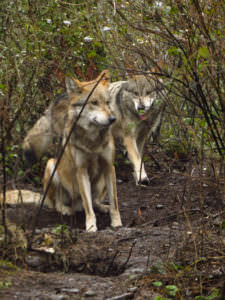Posturing
Today while doing the walk through I observed some posturing between our 3 sibling male Mexican gray wolves. The brothers, who are housed together, were born here at Wolf Haven (2 were born in 2007 and the other in 2008) . While the boys lived with their parents and female siblings for several years, they have been living alone as bachelors since 2010.
Fortunately they had the benefit of being parent reared and as such, learned appropriate behavior. We would often observe (via remote camera) the parents chastising the pups when they got out of line and because they were a multigenerational group, they had lots of siblings (8) to not only play with, but to practice ritualized fighting with as well, subsequently developing good social skills.
Even though the parents are the ones in charge, there is a linear hierarchy that exists within the group that is not only age graded, but sex graded as well- meaning that the males and females work out their own chain of command and rarely do dominance disputes cross gender lines. Very early on the 3 boys established a hierarchy among themselves and it has remained pretty stable up until recently. Even when they moved into their own enclosure, away from their sire, the male who had been in charge (M1066) retained the dominant role. However, the youngest of the 3, M1135 has started to test the waters this season and it appears that there may be a shift in dynamics. This is not uncommon, particularly in a disrupted pack. For although the alpha pair’s (or parents’) leadership will stay stable, the rest of the group’s dynamics are in flux. Things like dispersal, injury, or attrition can lead to an opportunity for a lower ranking animal to move up in status. In the case of captive wolves, something as seemingly benign as a move from one enclosure to another can prompt a shift.
So far, our 3 bachelors have lived a pretty peaceful coexistence. During breeding season we saw them periodically get a little testy with one another but usually it presented in raised tails and/or hackles. There were never any actual physical confrontations (that we observed). Same sex groupings, particularly males, seem to get along pretty well together – of course, all bets would be off if we were to introduce a female into the fray- and our boys are no exception.
Breeding season has come and gone, so naturally we would expect to see less posturing. However, today as I rounded the corner to their enclosure, I observed M1135 facing off with M1066-his tail and hackles were raised, his face was set in an agonistic pucker as he emitted a low growl. M1066 had his head turned away in avoidance, which is a submissive behavior, but the rest of his body language sent a different message. His tail and hackles were also raised and his body was rigid, indicating that he wasn’t quite ready to submit. However, his brother body slammed him and M1066 tucked his tail and turned away, redirecting towards the other brother, M1067, who is the lowest ranking of the 3.
There is never a dull moment when you work with animals (especially wolves) and it will be interesting to see how this all plays out. Stay tuned….

